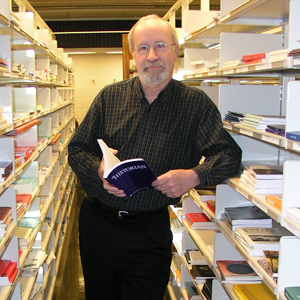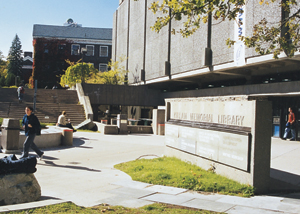 | ||
| University Librarian Bill Maes explains a new alternative that ensures access to valuable journals. | ||
Accessing journals at Dalhousie is now a lot easier, and the choice much greater thanks to steps taken by Bill Maes, Dalhousie University Librarian. After years of cuts to journal subscriptions, Mr. Maes embraced a new alternative that would ensure generous access to the publications faculty and students need.
Far from the days when the university had to purchase individual journal titles, Dalhousie is now utilizing electronic, on-line journals and getting far more bang for the buck. After joining the Canadian Research Knowledge Network consortium (over 70 AUCC-affiliated members) in 2001, Dalhousie now has access to as many as 15,5000 individual titles - up from 4000 in both electronic and print five years ago.
"It's quite exciting," says an enthusiastic Mr. Maes. "It's an untold story. The quality and quantity of academic journals to which we have access at Dal is sometimes taken for granted but it's a major step forward for the university."
Mr. Maes took the initiative to join CRKN four years ago taking advantage of CFI funds to provide electronic access to a large number of journals in the face of continuing financial restraints. Over a three year period CFI contributed 40 per cent of the funds to help the library increase access to electronic journal resources in Science, Technology and Medicine.
Prior to involvement in the consortium, Dalhousie would purchase 10 or 15 titles at a time. Now we are able to purchase the complete offerings of a particular publisher through CRKN. Licences typically include access to current issues as well as several years of backfiles and CRKN established a solid licensing agreement that gives us ownership in perpetuity of the collections to which we subscribe. "They continue to find us new deals," says Mr. Maes. "One example is an agreement with Elsevier. The library used to pay $700,000 for 260 titles. With the new agreement, for $100,000 more, Dalhousie has access to everything they publish (1500 titles) plus access to five or more years of back files. Without the agreement $100,000 would have purchased only another 100 titles or less. We used to have to drop titles because we couldn't afford them but now new worlds have opened up."
He goes on to add: "The most recent deal we made two weeks ago through CRKN was with the Royal Society of Chemistry which has titles going back to 1878. For a $30,000 one time fee we now have total access to this collection. Chemists will be just laughing. They have all of the American Chemical Society's journals, a wonderful search engine which allows individuals to search by formuale, by diagrams and so on; and they have all these back files. Not only have we increased easy access to titles but we have also increased the searchability. In the days of only print journals you basically had, author, title, subject. In this case you can search for pretty much anything you like using whatever information you have."
Arts and Social Sciences material in digital form
 | ||
| Killam Memorial Library | ||
It's not just science publications that are coming to the university in greater number, though Arts and Social Sciences journals have been slower to arrive. "The arts and social sciences are coming around," says Mr. Maes. "Fewer publications in these disciplines are in digital form, though it's a growing number. The focus for many years has been on science and medicine; we were focused on how to get those costs down, and rightly arts and social sciences have felt a little left out.
One of the mandates given to CRKN is to put together a package of arts and social sciences material in digital form. Since the cost of titles is so low in these disciplines we're looking for digitized packages of material that we can purchase one time. For example, (there is) the Canadian Poetry Journal which has full text files which we would simply prefer to purchase outright. There are similar databases like the one we purchased a little over a year ago: a collection of 18th century books (about 700.000 titles) that are available on-line in a PDF format. You can imagine it could be a history prof, it could be a literature prof, they can now present these in class with full access to everyone. Formerly they had to send students to look at microfilm copies of the books housed in the library and wait in line for the privilege. It's very exciting. It will provide a lot more interesting ways to do research; new ways to research old documents and make it faster."
Future opportunities 'limitless'
Of course there are drawbacks, especially to any emerging technology. Mr. Maes points to technical failures that could make it difficult to access information electronically. In the case of a major power failure, if technical backup doesn't work, you could lose access to a great deal of information. However, he points out that when you go back o print days there were problems too; an article might have been ripped out of a journal, or in some cases students would hide articles in the stacks making it hard for other students to obtain. But now these issues won't matter because journals can be used by one or 20,000 readers at a time. The upsides easily outweigh the downsides, he says.
Access to journals has come a long way from Mr. Maes' own student days: "When I was a student I had to go sit in the stacks with a journal and write by hand the quotations I needed to use in my paper, or if I felt I had enough money, I could bring a pile of journals to the photocopier. there was a very different way of doing things then. I think people sometimes forget just how far we've come."
Mr. Maes renewed the deal with CRKN last month and the future opportunities look to be limitless what with web publishing and further increased on-line access. Mr. Maes doubts that 'everything' will one day be available electronically - he says there are some things that are better on paper - but he is excited about what may come not too far into the future.
"I think we will see the day when we could have a leather binder with about three sheets of electronic 'readable' paper, that would serve up all the texts one needed for any particular project. We are very much at the beginning of all this and we don't know where it's going to end. These are fantastic times."
